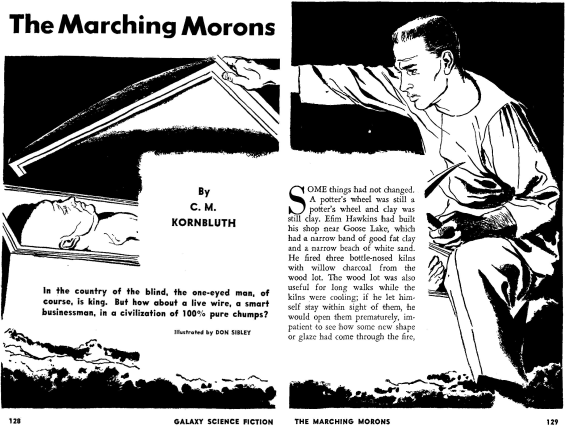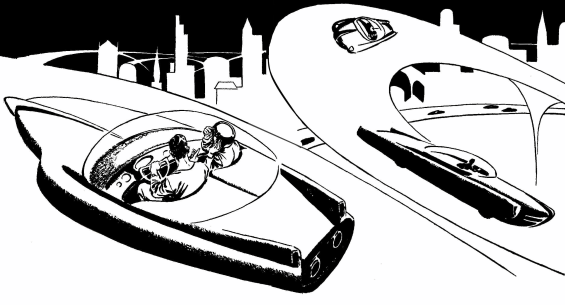
 The SFFaudio Podcast #112 – a complete and unabridged reading of The Marching Morons by C.M. Kornbluth. It is wonderfully narrated for us by William Coon of Eloquent Voice.
The SFFaudio Podcast #112 – a complete and unabridged reading of The Marching Morons by C.M. Kornbluth. It is wonderfully narrated for us by William Coon of Eloquent Voice.
The Marching Morons is a Science Fiction novella written by Cyril M. Kornbluth, originally published in Galaxy Science Fiction’s April 1951 issue. It has been famously anthologized in The Science Fiction Hall of Fame, Volume Two (B).
The story is set hundreds of years in the future: the date is 7-B-936. Its protagonist is John Barlow, a man from the past put into suspended animation by a freak accident involving a dental drill and anesthesia. He is revived in a dystopic future where the dysgenic breeding of humans has, in combination with intelligent people not having many children, overwhelmingly populated the world with morons. An elite few non-idiots must work slavishly to keep the world productive. Barlow, who was a shrewd con man in his day, has a solution to sell to the elite.
In his introduction to The Best Of C.M. Kornbluth Frederik Pohl explains some of the inspiration to The Marching Morons. Apparently the work was written after Pohl suggested that Kornbluth write a follow-up story to The Little Black Bag (a classic Kornbluth short story). In contrast to the “little black bag” arriving in the past from the future, Kornbluth wanted to write about a man arriving in the future from the past. To explain sending a man to the future, Kornbluth borrowed from David Butler’s Just Imagine (1930) science fiction film in which a man is struck by lightning, trapped in suspended animation, and reanimated in the future.”


Posted by Jesse Willis
Characters:
Efim Hawkins – A potter owning a shop near a lake. Often goes for walks through the woods while waiting for his kilns to cool. An “all around man.” Reanimated Barlow with 60cc of “simple saline in the trigeminal nerve.”
John Barlow – A real estate agent from the past (1988). Put in a state of suspended animation after a freak dentist accident involving an electrical shock and the “experimental anesthetic Cycloparadimethanol-B-7” (known as “Levantman shock” in the future).
Tinny-Peete – A psychist.
Ryan-Ngana – (Hawk-faced man) Meets with Tinny-Peete and Barlow.
Uh, guys? This was a bad, bad story. Just dreadful. Offensively bad. I’m curious why you ran it.
(The narration was excellent, however.)
You’re right, it is bad
We ran it sadly, because two examples of GREAT SF dealing with the topic, Ted Chiang’s Understand and Daniel Keyes’ Flowers For Algernon, were unavailable.
The Marching Morons is bad in a couple of ways. First, it is bad in the sense that the writing isn’t very good. Kornbluth has never impressed me as a good writer (except perhaps as a collaborator). Second, the premise of The Marching Morons is flawed. Deeply, deeply flawed.
But on the other hand, it is a public domain story, and I don’t think anyone knew that!
A crappy public domain story. Who cares?
I do.
At least enough to tell folks, and this site is about audio.
Just think, William Coon’s narration saved all us SF scholars from having to read it ourselves!
And seriously, even though it is crappy it has historical and scholarly value (it’s in THE SCIENCE FICTION HALL OF FAME). It’s a part of SF history. There’s a reason for that, even in badly written stories, with flawed premises, we can find value.
Take, THE COLD EQUATIONS by Tom Godwin. It is a very crappily written story (with a valuable message). It’s important, and worth reading despite that.
It is the same reason the study of philosophy is the study of millennia of flawed premises and mistaken arguments – we learn from the mistakes and thus see how fruitful ideas are built upon the less fruitful.
Science Fiction is a dialogue of ideas, stories replying to stories. And I think you will see that the conversation (a topic episode on the subject of STUPIDITY and INTELLIGENCE) that’s set to air next week will redeem the choice some. We talk about the story a bit, and I think I even mention how bad it is.
In short mea culpa, but I’m not wrong. ;)
BTW, be sure to check out Just Imagine, it’s bad too, but in a good way – it’s quaint and the FX are shockingly good for 1930s. It’s a comedy, more of a Marx brothers style movie than anything else.
Bad? Sounds just like everything to come out of Washington, DC for years now.
It’s a masterpiece, written beautifully. CM had a intellectually disabled son. The SFWA put it in a group of the greatest novellas and novelettes if all time.
It is not about idiots, per se. It is about the forces that relentlessly degrade culture and kill people as a result. Kornbluth was not a man with a strong Constitution. He had a safe job in a factory.he VOLUNTEERED for infantry service, was a machine gunner in The Bulge, earned a Bronze Star for valor, but strained his heart in the fighting. At age 35, he died from malignant hypertension complications. He was Jewish.
A brilliant story, brilliantly told. From a genuine war hero who deeply loved America (see: “Not this August.”)
Aww, I always liked this story. Read it ages ago, so maybe I wouldn’t like the style now, as you folks mentioned above, but it always stuck in my memory. It seems like a lot of SF of that era tended to be rather prolix; I assume as they were writing per word. Not all authors, of course.
I always suspected that the goofy catchphrase, “I’d buy that for a Quarter…!” was adapted for RoboCop as the, “I’d Buy That For a Dollar…!” And according to Wikipedia (I think that’s where I read this,) it was.
Verhoven definitely drew upon SF literature!